VOLKSWAGEN TIGUAN 2017 Owner´s Manual
Manufacturer: VOLKSWAGEN, Model Year: 2017, Model line: TIGUAN, Model: VOLKSWAGEN TIGUAN 2017Pages: 341, PDF Size: 9.14 MB
Page 31 of 341
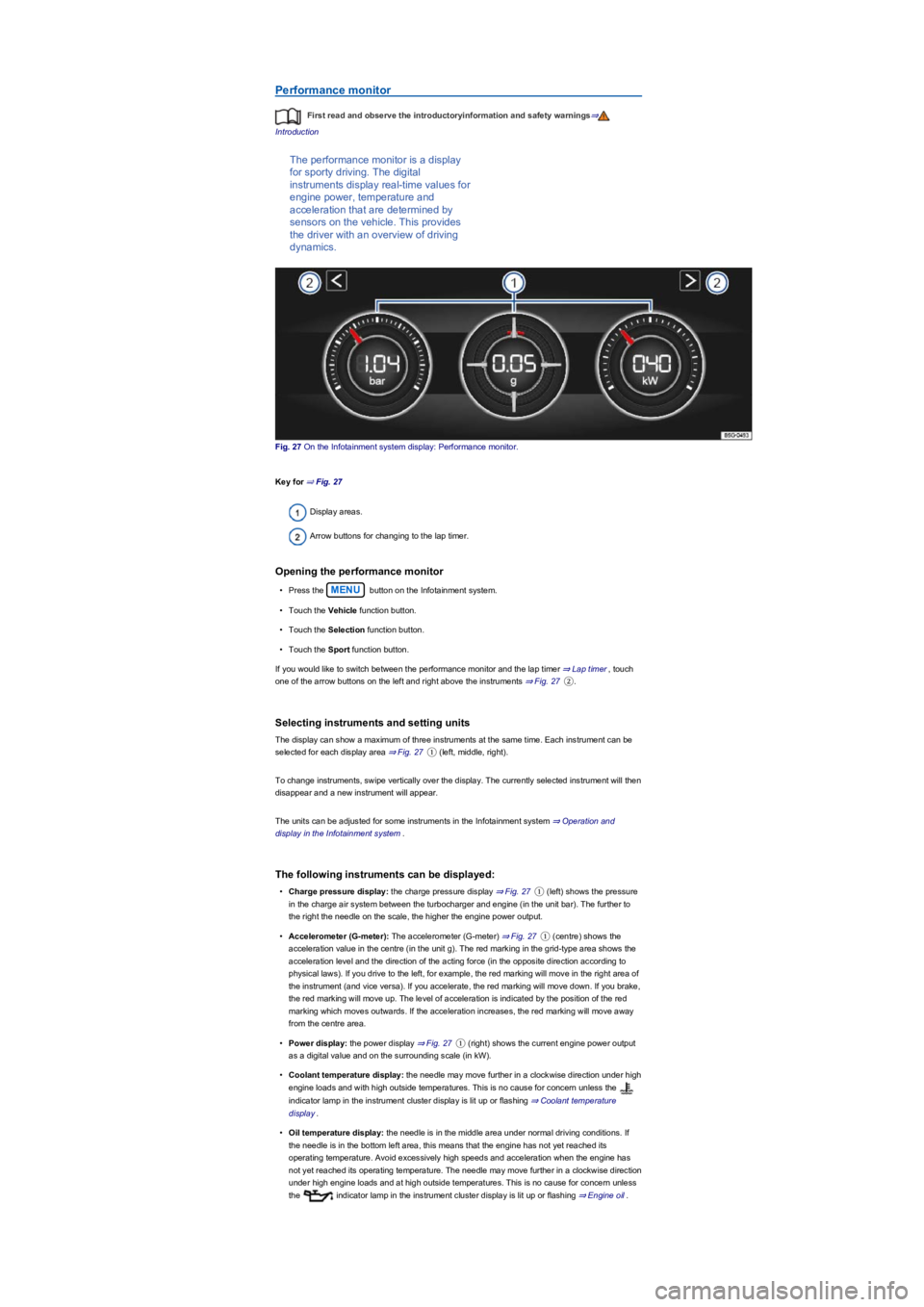
Performance monitor
First read and observe the introductoryinformation and safety warnings⇒
Introduction
The performance monitor is a display
for sporty driving. The digital
instruments display real-time values for
engine power, temperature and
acceleration that are determined by
sensors on the vehicle. This provides
the driver with an overview of driving
dynamics.
Fig. 27 On the Infotainment system display: Performance monitor.
Key for ⇒ Fig. 27
Display areas.
Arrow buttons for changing to the lap timer.
Opening the performance monitor
•Press the MENU button on the Infotainment system.
•Touch the Vehicle function button.
•Touch the Selection function button.
•Touch the Sport function button.
If you would like to switch between the performance monitor and the lap timer ⇒ Lap timer, touch
one of the arrow buttons on the left and right above the instruments ⇒ Fig. 27②.
Selecting instruments and setting units
The display can show a maximum of three instruments at the same time. Each instrument can be
selected for each display area ⇒ Fig. 27① (left, middle, right).
To change instruments, swipe vertically over the display. The currently selected instrument will then
disappear and a new instrument will appear.
The units can be adjusted for some instruments in the Infotainment system ⇒ Operation and
display in the Infotainment system.
The following instruments can be displayed:
•Charge pressure display: the charge pressure display ⇒ Fig. 27① (left) shows the pressure
in the charge air system between the turbocharger and engine (in the unit bar). The further to
the right the needle on the scale, the higher the engine power output.
•Accelerometer (G-meter): The accelerometer (G-meter) ⇒ Fig. 27① (centre) shows the
acceleration value in the centre (in the unit g). The red marking in the grid-type area shows the
acceleration level and the direction of the acting force (in the opposite direction according to
physical laws). If you drive to the left, for example, the red marking will move in the right area of
the instrument (and vice versa). If you accelerate, the red marking will move down. If you brake,
the red marking will move up. The level of acceleration is indicated by the position of the red
marking which moves outwards. If the acceleration increases, the red marking will move away
from the centre area.
•Power display: the power display ⇒ Fig. 27① (right) shows the current engine power output
as a digital value and on the surrounding scale (in kW).
•Coolant temperature display: the needle may move further in a clockwise direction under high
engine loads and with high outside temperatures. This is no cause for concern unless the
indicator lamp in the instrument cluster display is lit up or flashing ⇒ Coolant temperature
display.
•Oil temperature display: the needle is in the middle area under normal driving conditions. If
the needle is in the bottom left area, this means that the engine has not yet reached its
operating temperature. Avoid excessively high speeds and acceleration when the engine has
not yet reached its operating temperature. The needle may move further in a clockwise direction
under high engine loads and at high outside temperatures. This is no cause for concern unless
the indicator lamp in the instrument cluster display is lit up or flashing ⇒ Engine oil.
Page 32 of 341
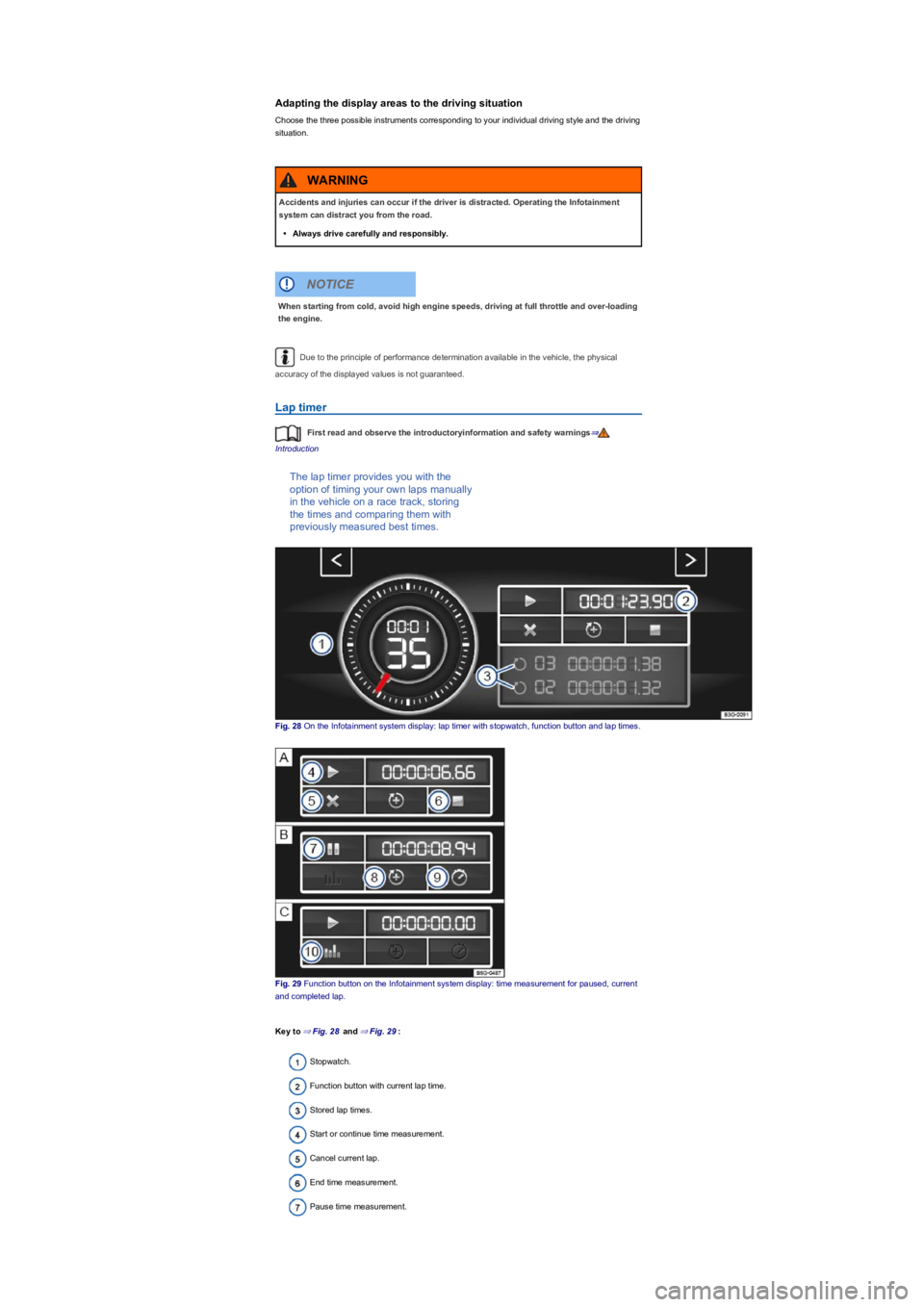
Adapting the display areas to the driving situation
Choose the three possible instruments corresponding to your individual driving style and the driving
situation.
Due to the principle of performance determination available in the vehicle, the physical
accuracy of the displayed values is not guaranteed.
Lap timer
First read and observe the introductoryinformation and safety warnings⇒
Introduction
The lap timer provides you with the
option of timing your own laps manually
in the vehicle on a race track, storing
the times and comparing them with
previously measured best times.
Fig. 28 On the Infotainment system display: lap timer with stopwatch, function button and lap times.
Fig. 29 Function button on the Infotainment system display: time measurement for paused, current
and completed lap.
Key to ⇒ Fig. 28 and ⇒ Fig. 29:
Stopwatch.
Function button with current lap time.
Stored lap times.
Start or continue time measurement.
Cancel current lap.
End time measurement.
Pause time measurement.
Accidents and injuries can occur if the driver is distracted. Operating the Infotainment
system can distract you from the road.
•Always drive carefully and responsibly.
WARNING
When starting from cold, avoid high engine speeds, driving at full throttle and over-loading
the engine.
NOTICE
Page 33 of 341

Start new lap.
Display split time.
Display statistics.
Opening the lap timer
To access the lap timer, first open the performance monitor ⇒ Performance monitor:
•Press the MENU button on the Infotainment system.
•Touch the Vehicle function button.
•Touch the Selection function button.
•Touch the Sport function button to access the performance monitor.
•Touch one of the arrow buttons ⇒ Fig. 27② in the performance monitor to change to the lap
timer.
You can change between the lap timer and performance monitor at any time using the arrow
buttons ⇒ Fig. 27- 2- and ⇒ Fig. 28.
Measuring lap times
The stopwatch measures the lap time in two areas:
The red needle and the numerical value in the centre show the running time in seconds. The
smaller display in the inner area shows minutes and hours.
The display on the right side shows the current lap time with an accuracy of 1/100 seconds. There
is no difference between the stopwatch and lap times if there are not yet any laps with intermediate
times stored in the lap timer.
FunctionOperation
Start or continue
time measurement
Touch the function button to start or continue ⇒ Fig. 29④.
Time measurement is not possible when the ignition is switched off. A
message is shown on the display.
Press Start to start time measurement. Time measurement starts as soon
as the vehicle moves forwards.
A new first lap can be started when the data in the statistics has been
reset.
End time
measurementTouch the function button to end measurement ⇒ Fig. 29⑥.
Pause time
measurementTouch the function button to pause measurement ⇒ Fig. 29⑦.
Start new lap
Touch the function button to add a new lap ⇒ Fig. 29⑧.
The last lap time is stored and a new lap starts. The overall time of the
laps driven is shown in the statistics.
Cancel current lap
Touch the function button to cancel the current lap ⇒ Fig. 29⑤.
During a running time measurement, touch the function button to pause
measurement ⑦. Time measurement is cancelled and the lap time
is deleted. --: --:--.-- is displayed in the statistics.
Display
intermediate time
Touch the function button for the intermediate time ⇒ Fig. 29⑨.
The stopwatch ⇒ Fig. 28① stops for a few seconds and the intermediate
time is displayed.
Display statistics
After ending or cancelling time measurement, touch the function button for
the statistics ⇒ Fig. 29⑩.
The statistics show the number of laps, the overall time, the fastest and
slowest laps, the average value of all lap times and all lap values.
Touch the function button to go back to the previous menu.
Reset data in the
statistics
Touch the function button for statistics ⇒ Fig. 29⑩. Delete the data
by touching the Reset function button.
A maximum of 99 laps and a maximum time of 99 hours, 59 minutes and 59 seconds can be
recorded. If one of these limits has been reached, the data in the statistics must be deleted before a
further time measurement.
Avoid operating the lap timer when the vehicle is in motion if possible.
•Preset lap timer settings and access statistics only when the vehicle is stationary.
•When the vehicle is in motion, use the lap timer only in driving situations which are
easy to control.
WARNING
Page 34 of 341
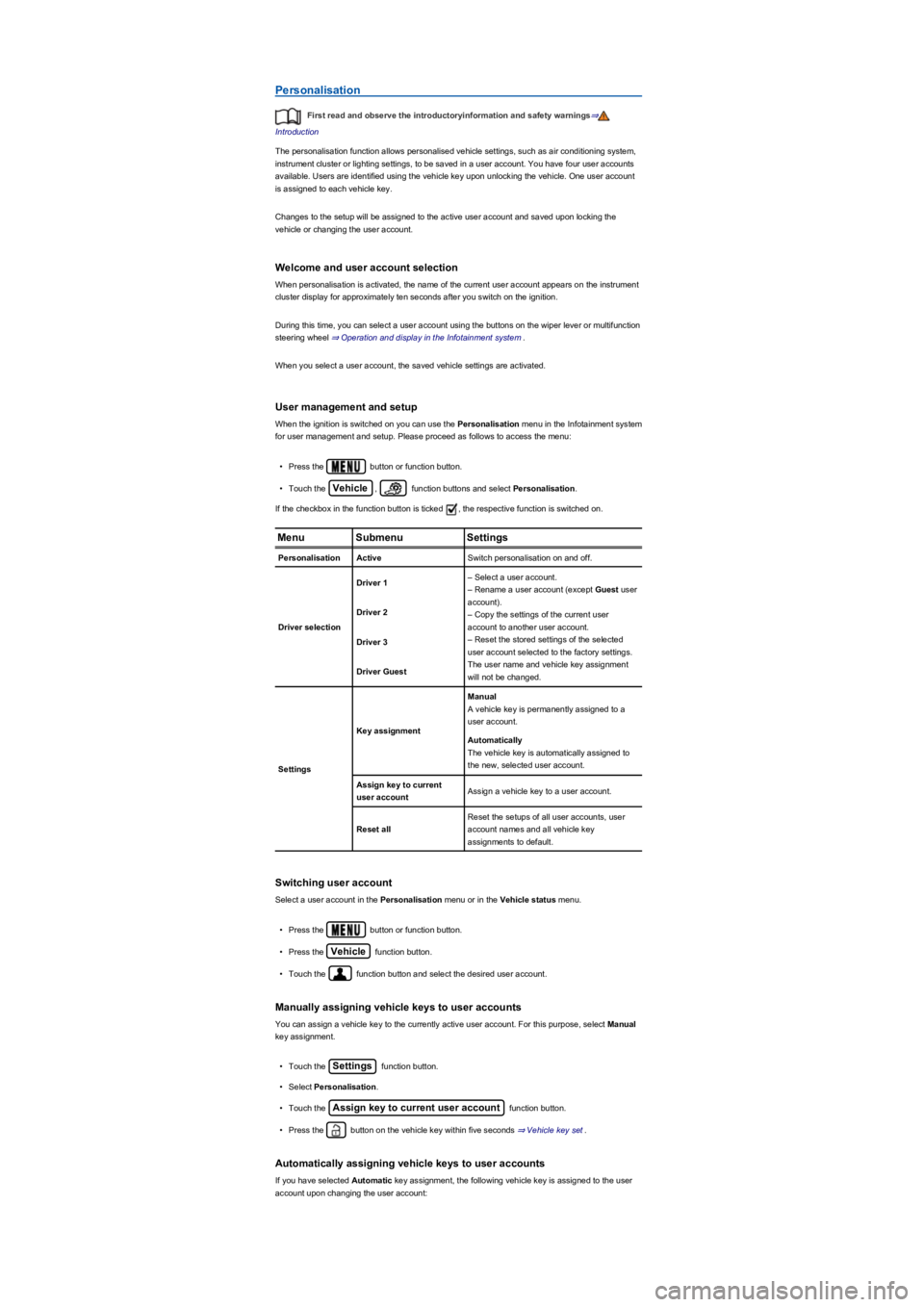
Personalisation
First read and observe the introductoryinformation and safety warnings⇒
Introduction
The personalisation function allows personalised vehicle settings, such as air conditioning system,
instrument cluster or lighting settings, to be saved in a user account. You have four user accounts
available. Users are identified using the vehicle key upon unlocking the vehicle. One user account
is assigned to each vehicle key.
Changes to the setup will be assigned to the active user account and saved upon locking the
vehicle or changing the user account.
Welcome and user account selection
When personalisation is activated, the name of the current user account appears on the instrument
cluster display for approximately ten seconds after you switch on the ignition.
During this time, you can select a user account using the buttons on the wiper lever or multifunction
steering wheel ⇒ Operation and display in the Infotainment system.
When you select a user account, the saved vehicle settings are activated.
User management and setup
When the ignition is switched on you can use the Personalisation menu in the Infotainment system
for user management and setup. Please proceed as follows to access the menu:
•Press the button or function button.
•Touch the Vehicle, function buttons and select Personalisation.
If the checkbox in the function button is ticked , the respective function is switched on.
MenuSubmenuSettings
PersonalisationActiveSwitch personalisation on and off.
Driver selection
Driver 1– Select a user account.
– Rename a user account (except Guest user
account).
– Copy the settings of the current user
account to another user account.
– Reset the stored settings of the selected
user account selected to the factory settings.
The user name and vehicle key assignment
will not be changed.
Driver 2
Driver 3
Driver Guest
Settings
Key assignment
Manual
A vehicle key is permanently assigned to a
user account.
Automatically
The vehicle key is automatically assigned to
the new, selected user account.
Assign key to current
user accountAssign a vehicle key to a user account.
Reset all
Reset the setups of all user accounts, user
account names and all vehicle key
assignments to default.
Switching user account
Select a user account in the Personalisation menu or in the Vehicle status menu.
•Press the button or function button.
•Press the Vehicle function button.
•Touch the function button and select the desired user account.
Manually assigning vehicle keys to user accounts
You can assign a vehicle key to the currently active user account. For this purpose, select Manual
key assignment.
•Touch the Settings function button.
•Select Personalisation.
•Touch the Assign key to current user account function button.
•Press the button on the vehicle key within five seconds ⇒ Vehicle key set.
Automatically assigning vehicle keys to user accounts
If you have selected Automatic key assignment, the following vehicle key is assigned to the user
account upon changing the user account:
Page 35 of 341
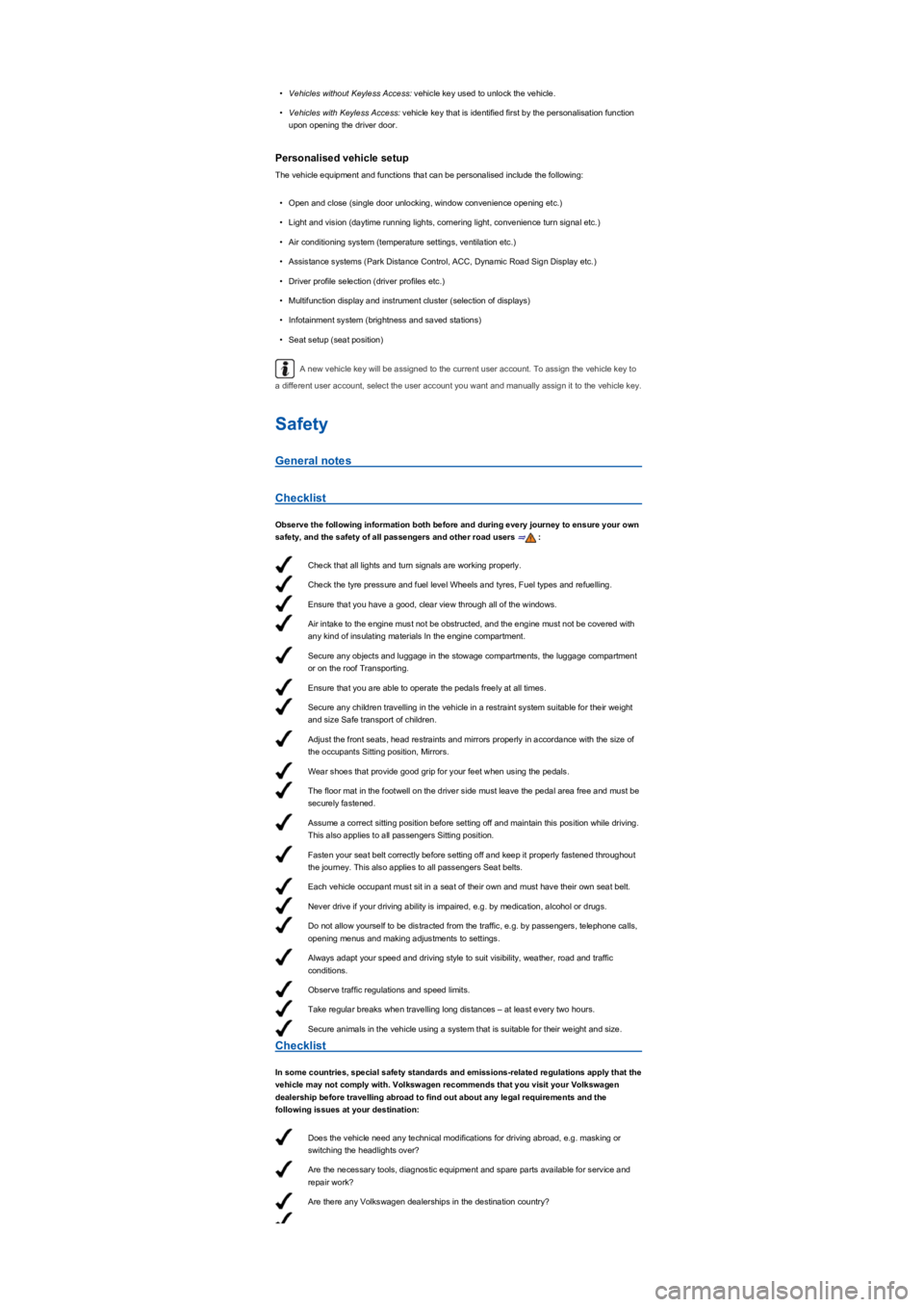
Check that all lights and turn signals are working properly.
Check the tyre pressure and fuel level Wheels and tyres, Fuel types and refuelling.
Ensure that you have a good, clear view through all of the windows.
Air intake to the engine must not be obstructed, and the engine must not be covered with
any kind of insulating materials In the engine compartment.
Secure any objects and luggage in the stowage compartments, the luggage compartment
or on the roof Transporting.
Ensure that you are able to operate the pedals freely at all times.
Secure any children travelling in the vehicle in a restraint system suitable for their weight
and size Safe transport of children.
Adjust the front seats, head restraints and mirrors properly in accordance with the size of
the occupants Sitting position, Mirrors.
Wear shoes that provide good grip for your feet when using the pedals.
The floor mat in the footwell on the driver side must leave the pedal area free and must be
securely fastened.
Assume a correct sitting position before setting off and maintain this position while driving.
This also applies to all passengers Sitting position.
Fasten your seat belt correctly before setting off and keep it properly fastened throughout
the journey. This also applies to all passengers Seat belts.
Each vehicle occupant must sit in a seat of their own and must have their own seat belt.
Never drive if your driving ability is impaired, e.g. by medication, alcohol or drugs.
Do not allow yourself to be distracted from the traffic, e.g. by passengers, telephone calls,
opening menus and making adjustments to settings.
Always adapt your speed and driving style to suit visibility, weather, road and traffic
conditions.
Observe traffic regulations and speed limits.
Take regular breaks when travelling long distances – at least every two hours.
Secure animals in the vehicle using a system that is suitable for their weight and size.
Does the vehicle need any technical modifications for driving abroad, e.g. masking or
switching the headlights over?
Are the necessary tools, diagnostic equipment and spare parts available for service and
repair work?
Are there any Volkswagen dealerships in the destination country?
•Vehicles without Keyless Access: vehicle key used to unlock the vehicle.
•Vehicles with Keyless Access: vehicle key that is identified first by the personalisation function
upon opening the driver door.
Personalised vehicle setup
The vehicle equipment and functions that can be personalised include the following:
•Open and close (single door unlocking, window convenience opening etc.)
•Light and vision (daytime running lights, cornering light, convenience turn signal etc.)
•Air conditioning system (temperature settings, ventilation etc.)
•Assistance systems (Park Distance Control, ACC, Dynamic Road Sign Display etc.)
•Driver profile selection (driver profiles etc.)
•Multifunction display and instrument cluster (selection of displays)
•Infotainment system (brightness and saved stations)
•Seat setup (seat position)
A new vehicle key will be assigned to the current user account. To assign the vehicle key to
a different user account, select the user account you want and manually assign it to the vehicle key.
Safety
General notes
Checklist
Observe the following information both before and during every journey to ensure your own
safety, and the safety of all passengers and other road users ⇒:
Checklist
In some countries, special safety standards and emissions-related regulations apply that the
vehicle may not comply with. Volkswagen recommends that you visit your Volkswagen
dealership before travelling abroad to find out about any legal requirements and the
following issues at your destination:
Page 36 of 341
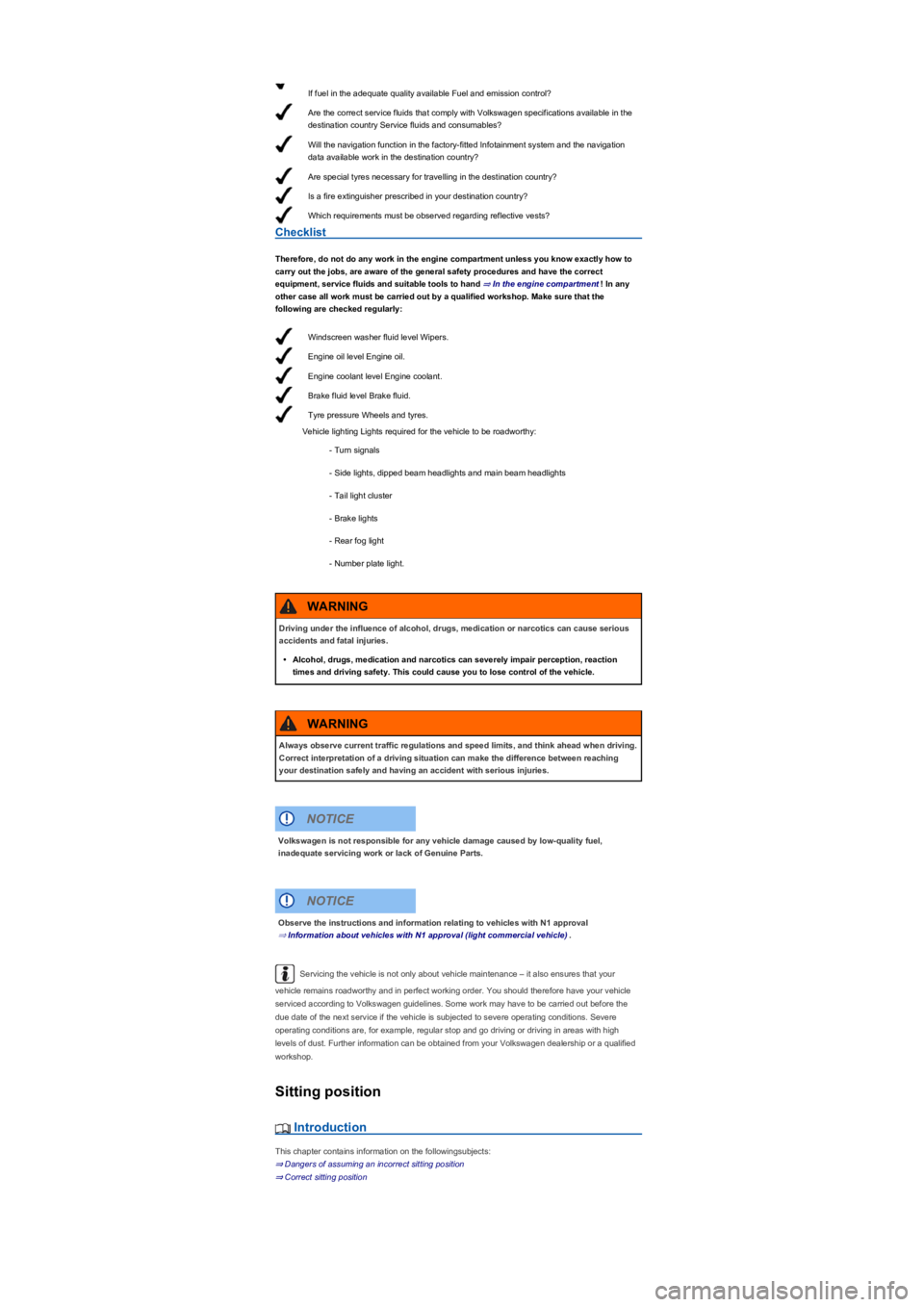
If fuel in the adequate quality available Fuel and emission control?
Are the correct service fluids that comply with Volkswagen specifications available in the
destination country Service fluids and consumables?
Will the navigation function in the factory-fitted Infotainment system and the navigation
data available work in the destination country?
Are special tyres necessary for travelling in the destination country?
Is a fire extinguisher prescribed in your destination country?
Which requirements must be observed regarding reflective vests?
Windscreen washer fluid level Wipers.
Engine oil level Engine oil.
Engine coolant level Engine coolant.
Brake fluid level Brake fluid.
Tyre pressure Wheels and tyres.
Checklist
Therefore, do not do any work in the engine compartment unless you know exactly how to
carry out the jobs, are aware of the general safety procedures and have the correct
equipment, service fluids and suitable tools to hand ⇒ In the engine compartment! In any
other case all work must be carried out by a qualified workshop. Make sure that the
following are checked regularly:
Vehicle lighting Lights required for the vehicle to be roadworthy:
- Turn signals
- Side lights, dipped beam headlights and main beam headlights
- Tail light cluster
- Brake lights
- Rear fog light
- Number plate light.
Servicing the vehicle is not only about vehicle maintenance – it also ensures that your
vehicle remains roadworthy and in perfect working order. You should therefore have your vehicle
serviced according to Volkswagen guidelines. Some work may have to be carried out before the
due date of the next service if the vehicle is subjected to severe operating conditions. Severe
operating conditions are, for example, regular stop and go driving or driving in areas with high
levels of dust. Further information can be obtained from your Volkswagen dealership or a qualified
workshop.
Sitting position
Introduction
This chapter contains information on the followingsubjects:
⇒ Dangers of assuming an incorrect sitting position
⇒ Correct sitting position
Driving under the influence of alcohol, drugs, medication or narcotics can cause serious
accidents and fatal injuries.
•Alcohol, drugs, medication and narcotics can severely impair perception, reaction
times and driving safety. This could cause you to lose control of the vehicle.
WARNING
Always observe current traffic regulations and speed limits, and think ahead when driving.
Correct interpretation of a driving situation can make the difference between reaching
your destination safely and having an accident with serious injuries.
WARNING
Volkswagen is not responsible for any vehicle damage caused by low-quality fuel,
inadequate servicing work or lack of Genuine Parts.
NOTICE
Observe the instructions and information relating to vehicles with N1 approval
⇒ Information about vehicles with N1 approval (light commercial vehicle).
NOTICE
Page 37 of 341
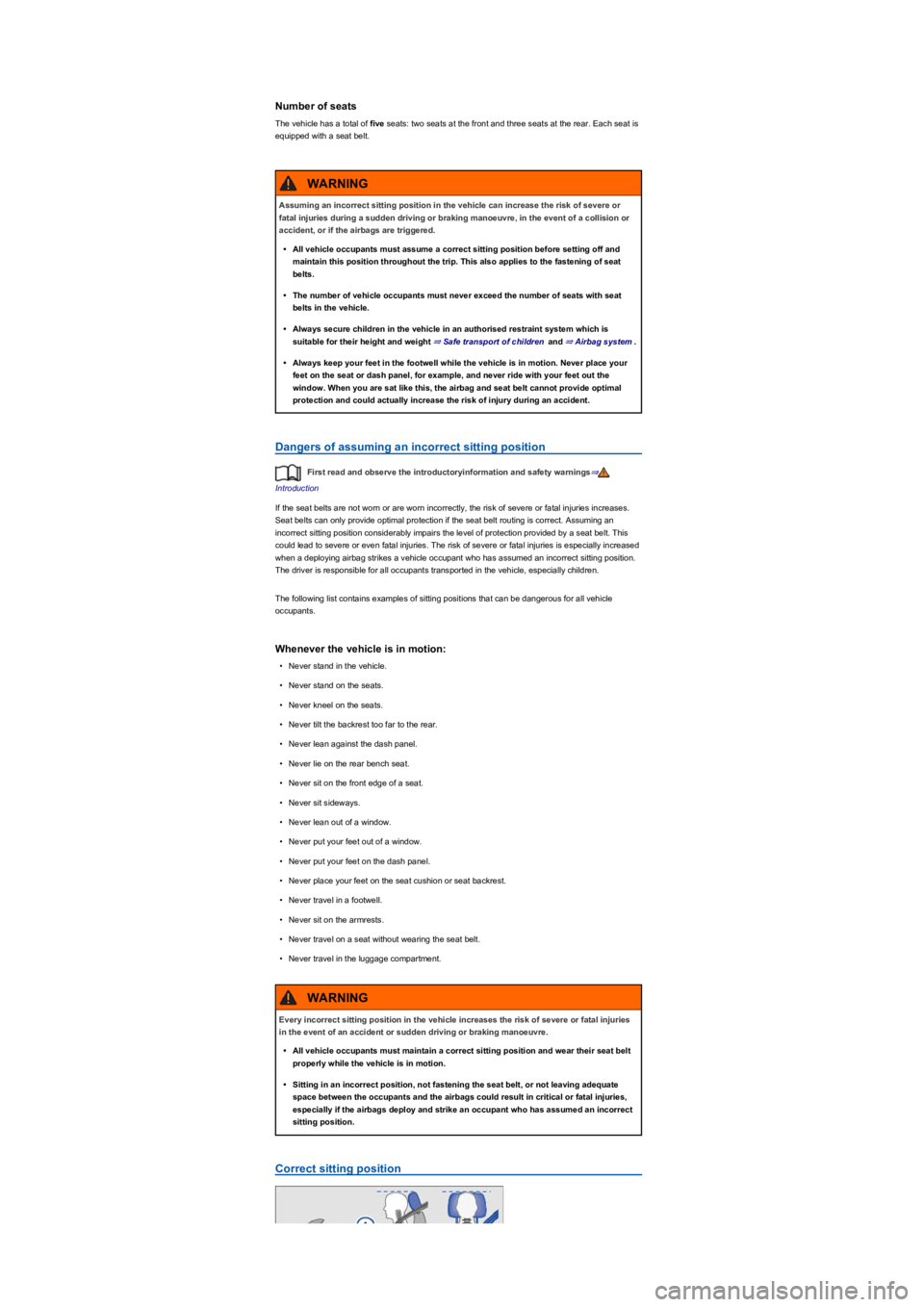
Number of seats
The vehicle has a total of five seats: two seats at the front and three seats at the rear. Each seat is
equipped with a seat belt.
Dangers of assuming an incorrect sitting position
First read and observe the introductoryinformation and safety warnings⇒
Introduction
If the seat belts are not worn or are worn incorrectly, the risk of severe or fatal injuries increases.
Seat belts can only provide optimal protection if the seat belt routing is correct. Assuming an
incorrect sitting position considerably impairs the level of protection provided by a seat belt. This
could lead to severe or even fatal injuries. The risk of severe or fatal injuries is especially increased
when a deploying airbag strikes a vehicle occupant who has assumed an incorrect sitting position.
The driver is responsible for all occupants transported in the vehicle, especially children.
The following list contains examples of sitting positions that can be dangerous for all vehicle
occupants.
Whenever the vehicle is in motion:
•Never stand in the vehicle.
•Never stand on the seats.
•Never kneel on the seats.
•Never tilt the backrest too far to the rear.
•Never lean against the dash panel.
•Never lie on the rear bench seat.
•Never sit on the front edge of a seat.
•Never sit sideways.
•Never lean out of a window.
•Never put your feet out of a window.
•Never put your feet on the dash panel.
•Never place your feet on the seat cushion or seat backrest.
•Never travel in a footwell.
•Never sit on the armrests.
•Never travel on a seat without wearing the seat belt.
•Never travel in the luggage compartment.
Correct sitting position
Assuming an incorrect sitting position in the vehicle can increase the risk of severe or
fatal injuries during a sudden driving or braking manoeuvre, in the event of a collision or
accident, or if the airbags are triggered.
•All vehicle occupants must assume a correct sitting position before setting off and
maintain this position throughout the trip. This also applies to the fastening of seat
belts.
•The number of vehicle occupants must never exceed the number of seats with seat
belts in the vehicle.
•Always secure children in the vehicle in an authorised restraint system which is
suitable for their height and weight ⇒ Safe transport of children and ⇒ Airbag system.
•Always keep your feet in the footwell while the vehicle is in motion. Never place your
feet on the seat or dash panel, for example, and never ride with your feet out the
window. When you are sat like this, the airbag and seat belt cannot provide optimal
protection and could actually increase the risk of injury during an accident.
WARNING
Every incorrect sitting position in the vehicle increases the risk of severe or fatal injuries
in the event of an accident or sudden driving or braking manoeuvre.
•All vehicle occupants must maintain a correct sitting position and wear their seat belt
properly while the vehicle is in motion.
•Sitting in an incorrect position, not fastening the seat belt, or not leaving adequate
space between the occupants and the airbags could result in critical or fatal injuries,
especially if the airbags deploy and strike an occupant who has assumed an incorrect
sitting position.
WARNING
Page 38 of 341
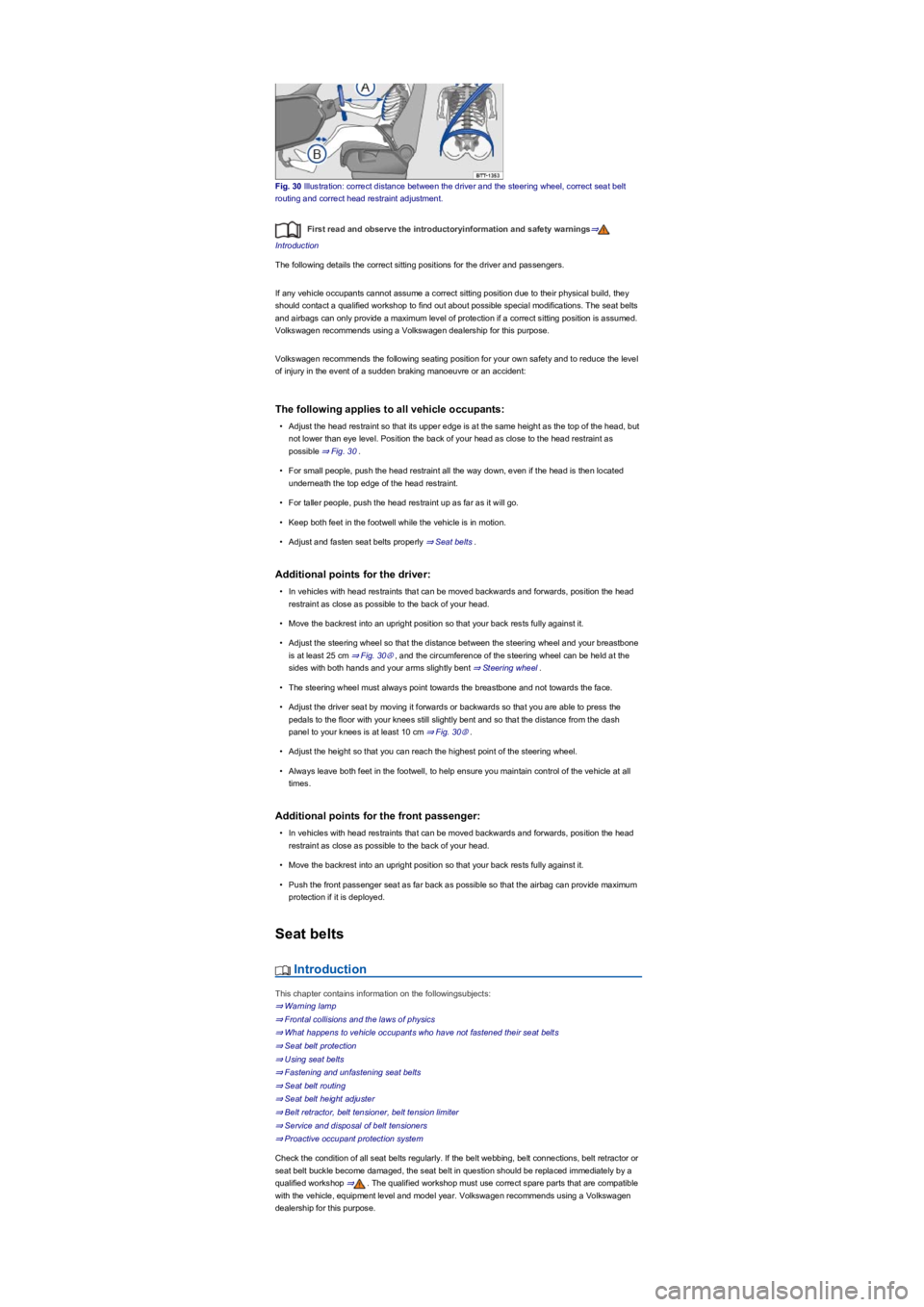
Fig. 30 Illustration: correct distance between the driver and the steering wheel, correct seat belt
routing and correct head restraint adjustment.
First read and observe the introductoryinformation and safety warnings⇒
Introduction
The following details the correct sitting positions for the driver and passengers.
If any vehicle occupants cannot assume a correct sitting position due to their physical build, they
should contact a qualified workshop to find out about possible special modifications. The seat belts
and airbags can only provide a maximum level of protection if a correct sitting position is assumed.
Volkswagen recommends using a Volkswagen dealership for this purpose.
Volkswagen recommends the following seating position for your own safety and to reduce the level
of injury in the event of a sudden braking manoeuvre or an accident:
The following applies to all vehicle occupants:
•Adjust the head restraint so that its upper edge is at the same height as the top of the head, but
not lower than eye level. Position the back of your head as close to the head restraint as
possible ⇒ Fig. 30.
•For small people, push the head restraint all the way down, even if the head is then located
underneath the top edge of the head restraint.
•For taller people, push the head restraint up as far as it will go.
•Keep both feet in the footwell while the vehicle is in motion.
•Adjust and fasten seat belts properly ⇒ Seat belts.
Additional points for the driver:
•In vehicles with head restraints that can be moved backwards and forwards, position the head
restraint as close as possible to the back of your head.
•Move the backrest into an upright position so that your back rests fully against it.
•Adjust the steering wheel so that the distance between the steering wheel and your breastbone
is at least 25 cm ⇒ Fig. 30Ⓐ, and the circumference of the steering wheel can be held at the
sides with both hands and your arms slightly bent ⇒ Steering wheel.
•The steering wheel must always point towards the breastbone and not towards the face.
•Adjust the driver seat by moving it forwards or backwards so that you are able to press the
pedals to the floor with your knees still slightly bent and so that the distance from the dash
panel to your knees is at least 10 cm ⇒ Fig. 30Ⓑ.
•Adjust the height so that you can reach the highest point of the steering wheel.
•Always leave both feet in the footwell, to help ensure you maintain control of the vehicle at all
times.
Additional points for the front passenger:
•In vehicles with head restraints that can be moved backwards and forwards, position the head
restraint as close as possible to the back of your head.
•Move the backrest into an upright position so that your back rests fully against it.
•Push the front passenger seat as far back as possible so that the airbag can provide maximum
protection if it is deployed.
Seat belts
Introduction
This chapter contains information on the followingsubjects:
⇒ Warning lamp
⇒ Frontal collisions and the laws of physics
⇒ What happens to vehicle occupants who have not fastened their seat belts
⇒ Seat belt protection
⇒ Using seat belts
⇒ Fastening and unfastening seat belts
⇒ Seat belt routing
⇒ Seat belt height adjuster
⇒ Belt retractor, belt tensioner, belt tension limiter
⇒ Service and disposal of belt tensioners
⇒ Proactive occupant protection system
Check the condition of all seat belts regularly. If the belt webbing, belt connections, belt retractor or
seat belt buckle become damaged, the seat belt in question should be replaced immediately by a
qualified workshop ⇒. The qualified workshop must use correct spare parts that are compatible
with the vehicle, equipment level and model year. Volkswagen recommends using a Volkswagen
dealership for this purpose.
Page 39 of 341
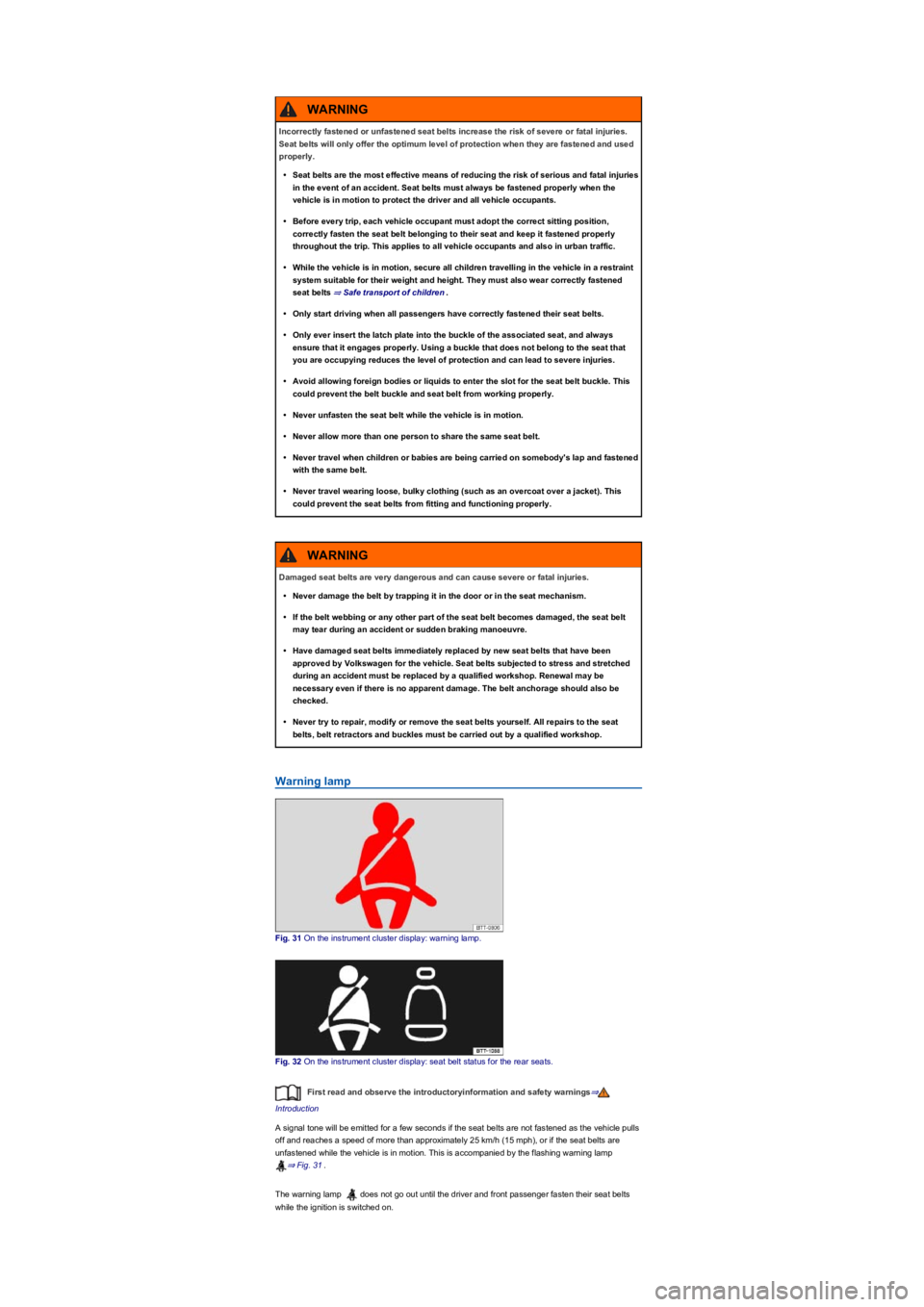
Warning lamp
Fig. 31 On the instrument cluster display: warning lamp.
Fig. 32 On the instrument cluster display: seat belt status for the rear seats.
First read and observe the introductoryinformation and safety warnings⇒
Introduction
A signal tone will be emitted for a few seconds if the seat belts are not fastened as the vehicle pulls
off and reaches a speed of more than approximately 25 km/h (15 mph), or if the seat belts are
unfastened while the vehicle is in motion. This is accompanied by the flashing warning lamp
⇒ Fig. 31.
The warning lamp does not go out until the driver and front passenger fasten their seat belts
while the ignition is switched on.
Incorrectly fastened or unfastened seat belts increase the risk of severe or fatal injuries.
Seat belts will only offer the optimum level of protection when they are fastened and used
properly.
•Seat belts are the most effective means of reducing the risk of serious and fatal injuries
in the event of an accident. Seat belts must always be fastened properly when the
vehicle is in motion to protect the driver and all vehicle occupants.
•Before every trip, each vehicle occupant must adopt the correct sitting position,
correctly fasten the seat belt belonging to their seat and keep it fastened properly
throughout the trip. This applies to all vehicle occupants and also in urban traffic.
•While the vehicle is in motion, secure all children travelling in the vehicle in a restraint
system suitable for their weight and height. They must also wear correctly fastened
seat belts ⇒ Safe transport of children.
•Only start driving when all passengers have correctly fastened their seat belts.
•Only ever insert the latch plate into the buckle of the associated seat, and always
ensure that it engages properly. Using a buckle that does not belong to the seat that
you are occupying reduces the level of protection and can lead to severe injuries.
•Avoid allowing foreign bodies or liquids to enter the slot for the seat belt buckle. This
could prevent the belt buckle and seat belt from working properly.
•Never unfasten the seat belt while the vehicle is in motion.
•Never allow more than one person to share the same seat belt.
•Never travel when children or babies are being carried on somebody's lap and fastened
with the same belt.
•Never travel wearing loose, bulky clothing (such as an overcoat over a jacket). This
could prevent the seat belts from fitting and functioning properly.
WARNING
Damaged seat belts are very dangerous and can cause severe or fatal injuries.
•Never damage the belt by trapping it in the door or in the seat mechanism.
•If the belt webbing or any other part of the seat belt becomes damaged, the seat belt
may tear during an accident or sudden braking manoeuvre.
•Have damaged seat belts immediately replaced by new seat belts that have been
approved by Volkswagen for the vehicle. Seat belts subjected to stress and stretched
during an accident must be replaced by a qualified workshop. Renewal may be
necessary even if there is no apparent damage. The belt anchorage should also be
checked.
•Never try to repair, modify or remove the seat belts yourself. All repairs to the seat
belts, belt retractors and buckles must be carried out by a qualified workshop.
WARNING
Page 40 of 341
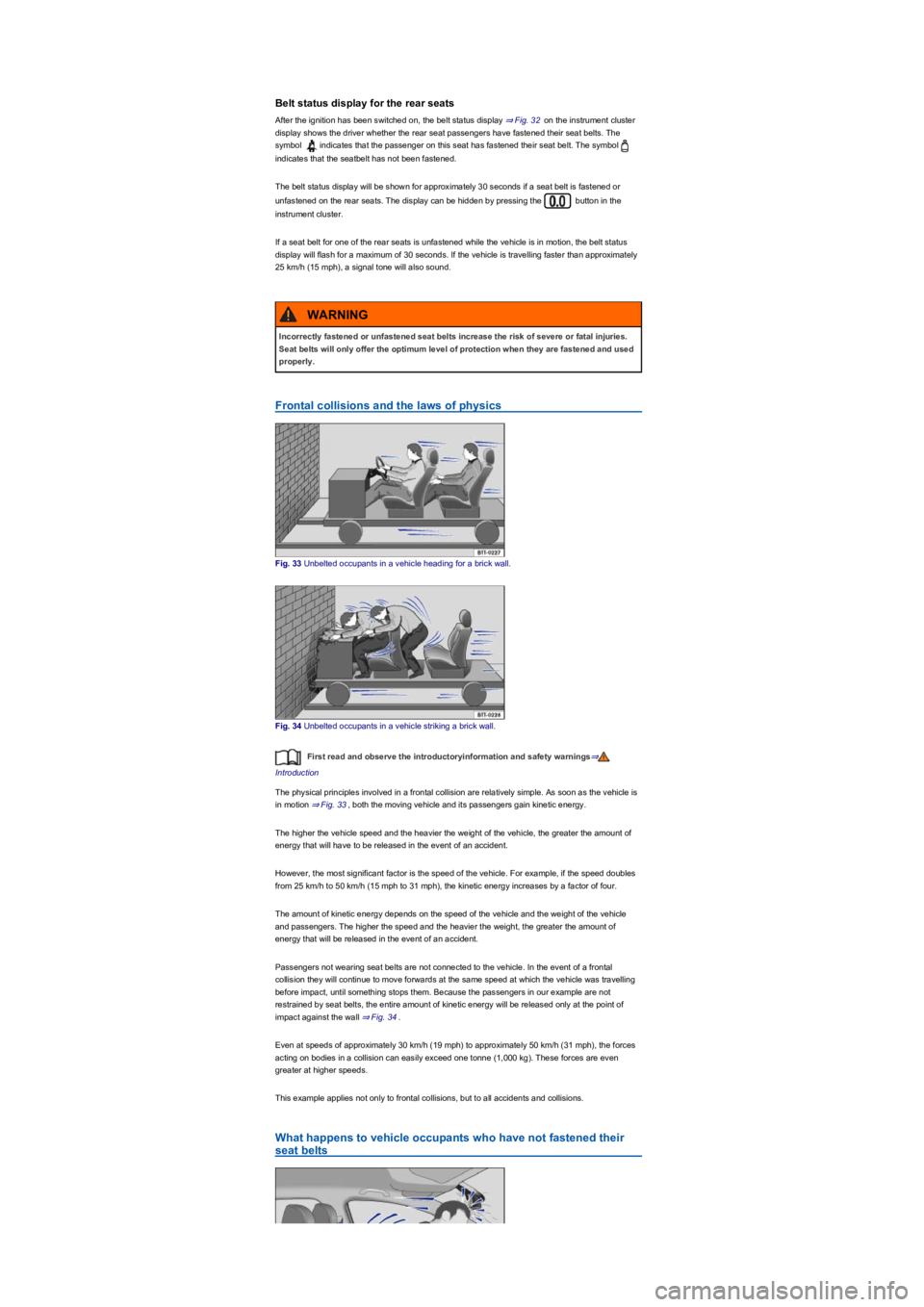
Belt status display for the rear seats
After the ignition has been switched on, the belt status display ⇒ Fig. 32 on the instrument cluster
display shows the driver whether the rear seat passengers have fastened their seat belts. The
symbol indicates that the passenger on this seat has fastened their seat belt. The symbol
indicates that the seatbelt has not been fastened.
The belt status display will be shown for approximately 30 seconds if a seat belt is fastened or
unfastened on the rear seats. The display can be hidden by pressing the button in the
instrument cluster.
If a seat belt for one of the rear seats is unfastened while the vehicle is in motion, the belt status
display will flash for a maximum of 30 seconds. If the vehicle is travelling faster than approximately
25 km/h (15 mph), a signal tone will also sound.
Frontal collisions and the laws of physics
Fig. 33 Unbelted occupants in a vehicle heading for a brick wall.
Fig. 34 Unbelted occupants in a vehicle striking a brick wall.
First read and observe the introductoryinformation and safety warnings⇒
Introduction
The physical principles involved in a frontal collision are relatively simple. As soon as the vehicle is
in motion ⇒ Fig. 33, both the moving vehicle and its passengers gain kinetic energy.
The higher the vehicle speed and the heavier the weight of the vehicle, the greater the amount of
energy that will have to be released in the event of an accident.
However, the most significant factor is the speed of the vehicle. For example, if the speed doubles
from 25 km/h to 50 km/h (15 mph to 31 mph), the kinetic energy increases by a factor of four.
The amount of kinetic energy depends on the speed of the vehicle and the weight of the vehicle
and passengers. The higher the speed and the heavier the weight, the greater the amount of
energy that will be released in the event of an accident.
Passengers not wearing seat belts are not connected to the vehicle. In the event of a frontal
collision they will continue to move forwards at the same speed at which the vehicle was travelling
before impact, until something stops them. Because the passengers in our example are not
restrained by seat belts, the entire amount of kinetic energy will be released only at the point of
impact against the wall ⇒ Fig. 34.
Even at speeds of approximately 30 km/h (19 mph) to approximately 50 km/h (31 mph), the forces
acting on bodies in a collision can easily exceed one tonne (1,000 kg). These forces are even
greater at higher speeds.
This example applies not only to frontal collisions, but to all accidents and collisions.
What happens to vehicle occupants who have not fastened their
seat belts
Incorrectly fastened or unfastened seat belts increase the risk of severe or fatal injuries.
Seat belts will only offer the optimum level of protection when they are fastened and used
properly.
WARNING